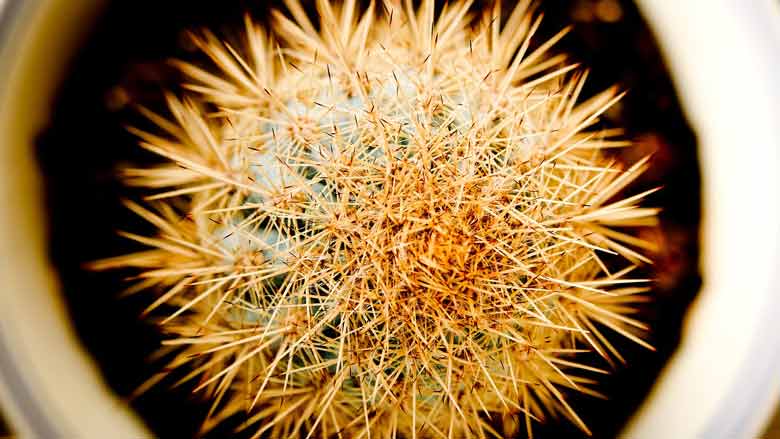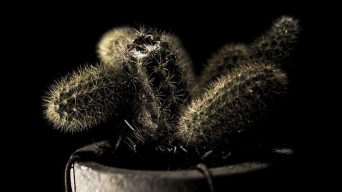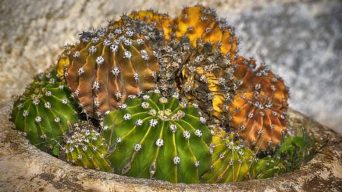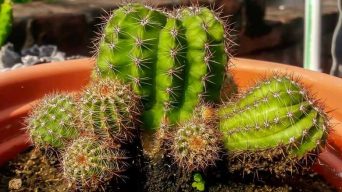To tell if a cactus is dead, look for signs like lightness or hollowness, wilting, color loss, growth cessation, shriveling, spine loss, mold or fungus, black or brown spots, foul smell, or mushy parts. These indicate possible health issues or death.
Do you know if your cactus is showing signs of distress?
Knowing how to tell if a cactus is dead is essential if you have cacti at home.
Cacti are popular houseplants because they can grow in dry climates without much care.
However, sometimes, even the most well-cared-for cactus will die.
You can watch out for some signs to determine if your plant has died or is dying.
If your cactus plant doesn’t seem happy anymore, read on below to find out what might be wrong!
How to Tell if a Cactus is Dead: 11 Key Signs to Look Out For
Cacti are renowned for their resilience, yet they have limits to how much neglect they can withstand.
If you observe your cactus appearing unwell or deteriorating, it’s crucial to identify specific indicators to decide if it can be salvaged.
Cacti typically don’t display indications of dying until they are close to the end of their life.
Once you detect these symptoms in your cactus, immediate action is necessary to attempt its revival.
The most common signs that a cactus is dying are:
1. The Cactus Plant Feels Light or Hollow
When assessing the health of a cactus, one key thing to consider is its weight and texture.
If your cactus feels light or hollow when you pick it up and shake it, it may be dying. This light indicates that the plant is no longer absorbing nutrients effectively through its roots and leaves, essential for survival.
A light or hollow cactus could signal the need for more frequent watering. Check the potting mix; if it’s dry, water the cactus thoroughly until the soil is uniformly moist. However, avoid overwatering, as it can damage the plant.
Root rot could be an issue in cases where regular watering is already being done.
Inspect the cactus roots for browning or a slimy texture to check for decay. If rot is present, gently lift the cactus from the soil and use kitchen shears, sterilized with alcohol, to trim off the affected areas.
Unfortunately, it might be too late to save the cactus if the rot is extensive.
2. The Cactus Is Wilting
A wilting cactus typically signals inadequate watering.
Verify this by checking if the soil is dry, and if so, water the cactus thoroughly until the soil is completely moist.
However, if your cactus continues to wilt despite regular watering, other problems may be present.
Examine the roots for signs of browning or rot, as these conditions can lead to wilting even with adequate hydration.
In cases of root rot, it may be necessary to remove all the affected soil and repot the cactus using fresh potting soil.
3. The Cactus Has Lost Its Color
A cactus may change or lose its color as it reaches the end of its life.
This may be a natural process that should not be seen as a cause for alarm. Cactus plants can change color dramatically during their lifetime due to environmental conditions such as sunlight exposure and temperature.
However, when you observe this happening with your own eyes or see other indications of a dying cactus, it’s time to evaluate whether your plant has perished.
The most obvious sign of a dead cactus is that the entire plant will be brown or gray and have lost its bright green pigment.
This happens because when a part of the body dies, the chlorophyll inside leaves with it.
In some cases, the stem or pads will be damaged so severely that they appear to have been burnt.
Again, not every brown or gray-looking plant means the end for your cactus.
However, if you see these in conjunction with other indicators, such as shriveling stems and dried-up stems, then there is a high likelihood that your cactus is dying and beyond saving.
4. The Cactus Has Stopped Growing
A cactus ceasing to grow can be one significant sign of declining health.
Should you observe that your cactus is no longer increasing in height or has slowed down considerably, it’s reasonable to be concerned.
However, it’s important to note that some cacti naturally expand slower.
Therefore, a lack of noticeable change in size doesn’t always indicate a problem, especially in young or newly acquired plants.
That said, if you’ve had your cactus for an extended period and it hasn’t shown any growth, this could be a cause for concern.
Often, a cactus that stops increasing in size is experiencing underlying issues.
If you’re worried about your cactus’s health, closely examining it for other indications of distress is advisable.
This proactive approach can help identify and address potential problems early on.
5. The Cactus Is Shriveled Up
Another sign that a cactus might be dying is if it is shriveled.
When the leaves turn brown and dry up, or the stem becomes brittle and starts to crack, there’s a good chance your cactus is in trouble.
If the soil is too dry, then this could be a sign that your cactus plant has been dehydrated and is dying.
If you notice any of these indications, then it’s time to take action and try to save your cactus.
Bring it inside and give it some water. If the cactus is in a pot, then make sure the pot has a drainage hole so the water can drain.
To revive your cactus, position it in a sunny location. Observe for improvement over the next few days. If there’s no change, it may be necessary to consider parting with the plant.
6. The Cactus Is Losing Its Spines
When a cactus is dying, its spines begin to fall off.
However, this loss doesn’t always signify the end for your plant.
Spines can drop due to various reasons, such as issues related to transplanting or natural processes.
If your cactus has been recently transplanted and is otherwise well-cared for, the falling off of spines might be a normal reaction. It doesn’t necessarily indicate that your plant is in peril.
But, if the spines continue to drop and there is no new growth, it could be a sign that it’s time to part ways with your cactus.
In these times, it’s crucial to observe other health indicators of your plant to make an informed decision.
7. The Cactus Is Covered in Mold or Fungus
A prominent sign of a dying cactus is if it becomes covered in mold or fungus.
If you see any black, green, or white patches on your cactus’ skin, it’s likely infected and must be treated immediately.
Cactus are very sensitive to mold or fungus, so if you have an infected cactus, take care of it as soon as possible.
While it may seem concerning, this doesn’t necessarily indicate that your plant has died.
Sometimes, a fungal infection can occur when the potting soil has become too moist, so all you may need to do is adjust the watering schedule and make sure the pot has proper drainage.
If you’re unsure whether your cactus has a fungus infection, look at the following article for more information: “How To Treat Fungus on Cactus Plants: A Complete Guide”.
8. The Cactus Has a Black or Brown Spot on It
When you notice a black or brown spot on your cactus, it could signify that the plant is dying.
Black or brown spots on your cactus are often symptoms of rot, which can be fatal if not addressed promptly.
These spots typically indicate the plants are at risk. Immediate action is crucial to save the cactus.
Start by carefully removing the cactus from its pot to examine for rot or mildew. If detected, repot the plant into fresh, cactus-appropriate soil.
In cases where rot or mildew is extensive, it might be necessary to replace the cactus.
However, if the cactus plant appears mostly healthy with limited affected areas, try cutting the diseased parts before repotting.
After successful intervention, the cactus should show new growth within weeks to months, signaling recovery.
10. The Cactus Has a Foul Smell Coming From It
A foul odor emanating from your cactus may indicate rot, a sign that the plant is decaying and potentially dying.
Rotting can be caused by overwatering, underwatering, or the plant being infested by insects.
Although rot can sometimes be treated, it is often better to cut the infected part of the plant off and throw it away.
If you do not catch the rot early enough, it can spread and kill the entire cactus.
A foul smell from a cactus generally indicates that the cactus is rotting and dying.
Symptoms of rotten cacti include a foul smell, an infestation by insects, or the plant being too wet or dry.
Rot can sometimes be treated, but it is generally better to cut off the infected part of the cactus and throw it away since this will likely spread to the rest of it and kill it.
11. Cacti Have Mushy, Molding Parts
If you notice that your cactus has mushy or molding parts, especially at the base, this can be another sign that the plant is dying.
his is commonly caused by overwatering or lack of water.
The cactus needs to dry out between watering, and if you leave the cactus in a humid area, it will begin to mold and rot.
You can try to revive a cactus with molding parts by removing the bad parts of the plant and letting it dry out for a few days.
If it is too far gone, the molding will continue to spread, and you may want to consider throwing away your cactus.
Preventing a Dying Cactus: Essential Maintenance Tips
Adopting a proactive approach to care is vital to keep your cacti thriving. Here are essential maintenance tips:
- Watering: Overwatering is a leading cause of cactus demise. Water only when the top inch of soil is dry, and reduce watering in winter when most cacti are dormant.
- Sunlight: Cacti need bright, indirect light. Place them where they get ample light but avoid the intense midday sun, particularly in summer.
- Temperature: Cactus plants prefer daytime temperatures of 70-80°F (21-27°C) and nighttime temperatures of 50-60°F (10-15°C). Keep them away from drafts and heat sources.
- Soil: Use a well-draining cactus mix to promote proper drainage and aeration, minimizing root rot risk.
- Potting: Select pots with drainage holes to prevent water buildup. Repot every two to three years for soil refreshment and root health checks.
- Fertilization: During the growing season (spring and summer), feed your cactus with a diluted, low-nitrogen fertilizer. Avoid fertilizing in winter.
- Pest and Disease Management: Regularly inspect for pests like mealybugs or spider mites. Apply suitable insecticides or natural remedies and isolate infected plants to halt the spread.
- Pruning: Use sterilized tools to remove dead or decaying parts, preventing infection and promoting healthy growth.
- Humidity Control: Cacti prefer dry conditions. Ensure good air circulation in humid areas.
- Regular Monitoring: Regularly check for stress, discoloration, or pests. Early detection is critical for effective treatment.
Adhering to these guidelines will help you prevent common problems, ensuring your cacti remain a beautiful and lively part of your home environment.
Final Thoughts
Cacti may not always be pristine, but that doesn’t necessarily signal their demise. A succulent with an unhealthy appearance might require extra attention and care to rejuvenate.
Known for their resilience, cacti can thrive for years with proper care. A cactus not flourishing as expected doesn’t always indicate a dying plant. These robust plants possess remarkable strength to recover from ailments or damage.
However, if your cactus shows several concerning signs, it may be time to consider if it’s a case of a cactus dying. Should there be no improvement after weeks or months, acquiring a new cactus plant could be the best course.
But if you give your cactus another chance, vigilant monitoring and dedicated care are essential for its potential regrowth. This proactive approach to gardening can lead to healthy and thriving cacti once again.







